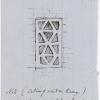‘Outline of Tracery’
Commentary
Page featuring an engraving (made after a drawing by Arthur Evans), captioned ‘Outline of Tracery’, published in Arthur J. Evans, Through Bosnia and the Herzegóvina on Foot during the Insurrection, August and September 1875 (London, 1876), p.23.
Artist: Unidentified engraver, after an original drawing [1941.8.171] by Arthur John Evans
Date of publication: 1876
Continent: Europe
Geographical area: Southern Europe
Country: Croatia
Region/Place: Zagreb
Cultural group: European Croat
Format: Woodcut engraving
Page size: 234 x 141 mm
Acquisition: Henry Balfour. Bequeathed February 1939
***
Research notes: It has been identified by Philip Grover that this woodcut engraving by an unnamed artist was based on an original drawing [1941.8.171] by Arthur John Evans, being the depiction of an unglazed, metal tracery window in a building (upper storey or outhouse) in Zagreb. It was published in Evans’ account of his journey, Through Bosnia and the Herzegóvina on Foot during the Insurrection, August and September 1875 (London, 1876), p.23, printed with the caption ‘Outline of Tracery’. Evans recorded in the volume: ‘It would be easy to show that the conical-shaped baskets, the Corpa, which the Croat countryman on p.4 has in his hand, is as like the Roman Corbisin form as it is in name, and may claim sisterhood with the Corbellaof the Campanian peasant of to-day. Some even of the windows of Agram have a Roman air, for in several upper-storeys and outhouses, to save glass, they are provided with a heavy unglazed plate tracery of an angular kind, which is an exact reproduction of the Roman tracery, to be seen, for example, in the Amphitheatre of Pola in Istria’: Through Bosnia and the Herzegóvina on Foot, p.23. Note that Agram is the German name for Zagreb, Croatia.

